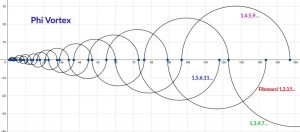…continued from The Secret of 10 and the River of Light, where from the unique 10-letter word in the Torah we were discussing the flow of Light through the 10 sefirot and the word river found concealed with it.
As previously discussed the word “the river” is found 21 times in the Torah and it’s usually translated as the Nile, and also the word “river” is found 151 times throughout the entire Tanakh. So it’s interesting that the first of what the Midrash enumerates as the 10 preeminent songs in the history of Israel–the 10 songs of thanks and redemption–is the “Song at the Sea” found at Shmot 15:1-21, paragraph 42.
The number 151 to any kabbalist is synonymous with the name of G-d, Ehyeh spelled out with heys (ELP HH YVD HH) and also the word mikve, the ritual cleansing bath so important for removing negativity. Moreover, the 21 verses of the “Song of the Sea” also correspond to that same higher Name of G-d, the Name at the level of Binah, Ehyeh, whose numerical value is 21, just like the 21 times “the River” is mentioned in the Torah.
And because Miriam’s Song goes hand in hand with the “Song of the Sea” as an intercalated response on behalf of the women to the men’s verses, 1 for 1, we have 21 + 21 verses = 42.
River, Sea, Mikve, Ehyeh; 42-Letter Name; It all seems to be interconnected pretty tightly.
Arguably, the passing through the sea was akin to a huge Mikve and final cleansing of the Israelites on their way to receiving the Torah at Sinai and to complete their 42 journeys in order to reach the Promised Land. And while the first word of the liturgical poem (Ana B’koach) that accompanies the 42 letters is Ana (ENE) of small gematria value 151, the first letters of the first 3 lines of the 42 Letter (6 x 7) matrix are EKN of numerical value 151, so not only is this connection far from coincidental, but one of the purposes of the 42-letter name is to act as a mikve and cleansing away of the klippot (negative shells) and selfish desires for our prayers as they pass from malchut through Zeir Apin to Binah and the upper worlds.
The Ana B’koach (42-Letter Name) is a river, a river we can sail at any moment. (For sailing lessons see The Genesis Prayer)
This auto-cleansing mechanism is one reason why the 42-Letter Name cannot be used negatively, as opposed to many other Names whose usage can backfire, as advised by Rabbi Chaim Vittal of blessed memory, unless we’re in a highly pure and holy state. When the Ana B’Koach is recited, the dams are released from below and the waters rise up. With most other Names, we’re calling upon them above and thus must be in a much holier (more righteous) place.
And along with our prayers, it’s our actions below that cause the waters (ma’im nukva) to ascend and for Heaven to respond and the river of light to drench/quench us. According to chazal, the equation is two drops from below cause one from above, and it’s illustrated in the Name Ehyeh Asher Ehyeh, whose two Ehyehs are 2 x 21 = 42 since both activated by the 42-letter Name (Shem Mem-Bet) recited below by us.
It takes two drops from below, and as illustrated by the Torah for us in its first song by the responsive singing of Miriam and Moses, the women and the men, the male and female attributes must be in harmony for heavenly light to flow freely.
It’s also an illustration that we need to show our appreciation and celebrate it with the community with enlivened joy, harmonizing our voices in one spirit and soul. When miracles are done for us, it may have been our personal actions that Heaven responded to, but they are for the benefit of everyone. Managing the waterworks is a community project if we want the waters to reach the trees and the fields and not just our own backyards.
Trees, Fields, Water and Moshiach
As Zion pointed out in the blog at www.RabbiShimon.com, the Tanakh has established the relationship between Man, trees, and the field with these two verses: (Jeremiah 17:8) וְהָיָה כְּעֵץ שָׁתוּל עַל-מַיִם “For he (man) shall be as a tree planted by the waters” and from parsha Shoftim, paragraph 73, which relates to Chochma/Wisdom (of gematria 73): (Deuteronomy 20:19) כִּי הָאָדָם עֵץ הַשָּׂדֶה “For is the tree of the field a man…”
Not only do these verses relate to Man as Zeir Anpin and our need to connect to the flowing water of the tree-of-life, but the verse Devarim 20:19 is also alluding to Moshiach, a man who will be the tree-of-life, and thus we find the reason why this verse, ostensibly about not cutting down trees that bear fruit during a siege, is found at paragraph 73, the numerical value of the sefira of Chochma (Wisdom) and at 20:19, an allusion to the year 2019 that, as explained in The Divine Calender and Nothing is Random in the Universe, the tzaddikim have designated as the year the reign of Mashiach will begin, at the tail end of 5778.
The full 6-word 18 letter phrase begins with Lo Ticrot, (LE TCRT) so the final letters of the phrase (ETYMZH) add up to 546 the 10 initials of the 10 sefirot (the tree-of-life), while we can permute the letters to H’Etz Emet (HYZ EMT), the Tree-of-Truth, which may be why the word H’Adam (“the man”) has the gematria sofit value of 611, that of Torah, which is known as Truth.
Moreover, the sum of the last two words in the verse add up 49 + 314= 363, the gematria of H’Moshiach (the Messiah). There’s much more divinity in this phrase, including the sum of the 6 words, plus the kolel of 6 equaling 1610 or 10 x 161, the highest value of Ehyeh, spelled out with yuds (ELP HY YVD HY), but back to the songs.
One last note for now about the” Song of the Sea:” if we examine its unique 3-column structure that all kabbalists agree mimics the 3-column structure of the tree-of-life, we see that the first four letters vertically of the right column spell out ELUL, as in the month of Elul (Virgo), the month of tshuvah (repentance), when we prepare for meeting the King of Kings on Rosh Hashanna. If we consider the 5 Mem-Bet Names of the 72 Names, as discussed in recent blogs, that were used to help split the Red Sea, separately, there are 72-5, or 67 other Names, and the gematria value of Elul is 67, the same as that of Binah (understanding). Binah is the upper sefira (dimension) associated with the Name Ehyeh. And it’s to Binah that are voices rise when we sing out in songs of praise and appreciation to G-d.
This is what the angels do every day, and what we do far too infrequently. We do do it as part of our daily and Shabbat prayers, but we have to ask ourselves if we’re doing it with the consciousness of appreciation or with a more robotic spirit. The beauty of the angels is that they can only focus on one thing, and when we are truly singing from our hearts, it’s very difficult to focus on anything else, which is why if we can shift our consciousness to true appreciation of all that G-d does for us and sing out loud, we can become like the angels and our words and spirits will elevate to Binah automatically. Our voices will be heard in Heaven above.
This is why there are 10 songs of appreciation in the Tanakh; this is why they are so important to us. There is little else that we can so easily do that will connect us to Binah. And that is also why singing songs of joy from our hearts makes us feels so good, so ecstatic. The Light is so pure.
And to show us what the songs of appreciation can lead to, we have initiating the top of the Torah column that “Song of the Sea” appears in, the letter hey (H). Normally, the 248 columns of the Torah begin with a Vav (V) but there are 6 special columns that begin with a different letter and these 6 letters spell out BYHShMV (In YH His Name, a reference to Mashiach) and their numerical value is 363, the same as H’Moshiach, “The Messiah.”
And the word that the letter Hey (H) occurs in at the top of this column is H’baim (HBEYM), and while some might say it looks like a permutation of the name Obama (EVBMH), it does for sure indicate by the letters Hey and Mem-Bet the 5 MB’s discussed above. And we could even say that the sofit gematria value of the word being 618 is a reference to the 6 words and 18 letter phrase from Devarim 20:19 also discussed above and often connected with this Torah portion.
Nevertheless, water, like Light, like wisdom, like the music and notes of song, flows, and should never stop, not even when we’re signing the 10th song in praise and appreciation of H’Moshiach.
This Shabbat take the extra time to do the kavannot (Focusing your arrows) on appreciation of Hashem and all He’s done for us before the songs, especially the Az Ishir (“Song of the Sea”) and sing from your heart with joy love and awe, celebrating with the community. And together, let’s split the Endless Sea (Ym Sof) that separates us from Moshiach, Hashem, and the tree-of-life reality. And B”H let it become a joyous habit for us.
…to be continued with our discussion of the 2nd Song, the “Song of the Well,” which is closely related to the “Song of the Sea” through the metaphor of water….


![Reblog this post [with Zemanta]](http://img.zemanta.com/reblog_e.png?x-id=d06d0515-e6fd-4f15-aef9-561ab45380a0)


